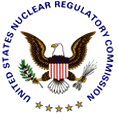| Search Options | ||||
| Index | Site Map | FAQ | Facility Info | Reading Rm | New | Help | Glossary | Contact Us | ||||

| Home > Electronic Reading Room > Document Collections > News Releases > 2001 > III-01-057 |
|||
 |
|
||
| No. III-01-057 | December 27, 2001 | |
| CONTACT: | Jan Strasma (630) 829-9663 Pam Alloway-Mueller (630) 829-9662 |
E-mail: opa3@nrc.gov |
NRC STAFF PROPOSES
$3,000 FINE AGAINST THE UNIVERSITY OF WISCONSIN- |
||
|
The Nuclear Regulatory Commission staff has proposed a $3,000 fine against the University of Wisconsin-Madison for violating NRC requirements associated with the loss of six plated radioactive sources during a renovation of a campus laboratory. The sources were being used to eliminate static in a research project. The university recovered two of the six sources. All six sources contained about 6.5 microcuries of americium-241, a radioactive isotope. Americium-241 is used in a variety of applications, including residential and commercial smoke detectors. The university lost the sources during the renovation of laboratory No. 342 in the Structural Botany Building during June. On September 27, the university reported the loss of three sources after having recovered two sources on September 13. The NRC subsequently determined that there was one additional source lost, making a total of four sources which remained lost. University officials believe the four sources were disposed of in the normal trash when the floor of the laboratory was cleaned. Following an investigation of the incident, the NRC staff determined that the university's failure to prevent the unauthorized removal or access to licensed material that was stored in controlled or unrestricted areas was a violation of NRC requirements. In notifying the university of the proposed fine, NRC Regional Administrator James E. Dyer said, "The failure to adequately secure and limit access to licensed material is a significant safety issue. Implementation of adequate security measures for licensed materials is intended to prevent members of the public from being unknowingly and unnecessarily exposed to radiation." Dyer noted that the university had taken corrective actions to prevent a recurrence of the situation, including conducting additional surveys of nearby areas and storing the two remaining sources in the radiation safety department. However, he said, a newly adopted enforcement policy provides that a fine be proposed to reflect the significance of the violation and emphasize the importance of maintaining control of licensed material. The specified fines included in the enforcement policy were developed to correspond to roughly three times the cost of proper disposal of radioactive material. The university has 30 days to pay the fine or protest it. If the fine is protested and subsequently imposed by the NRC staff, the company may request a hearing. |
||
|
Privacy Policy |
Site Disclaimer |